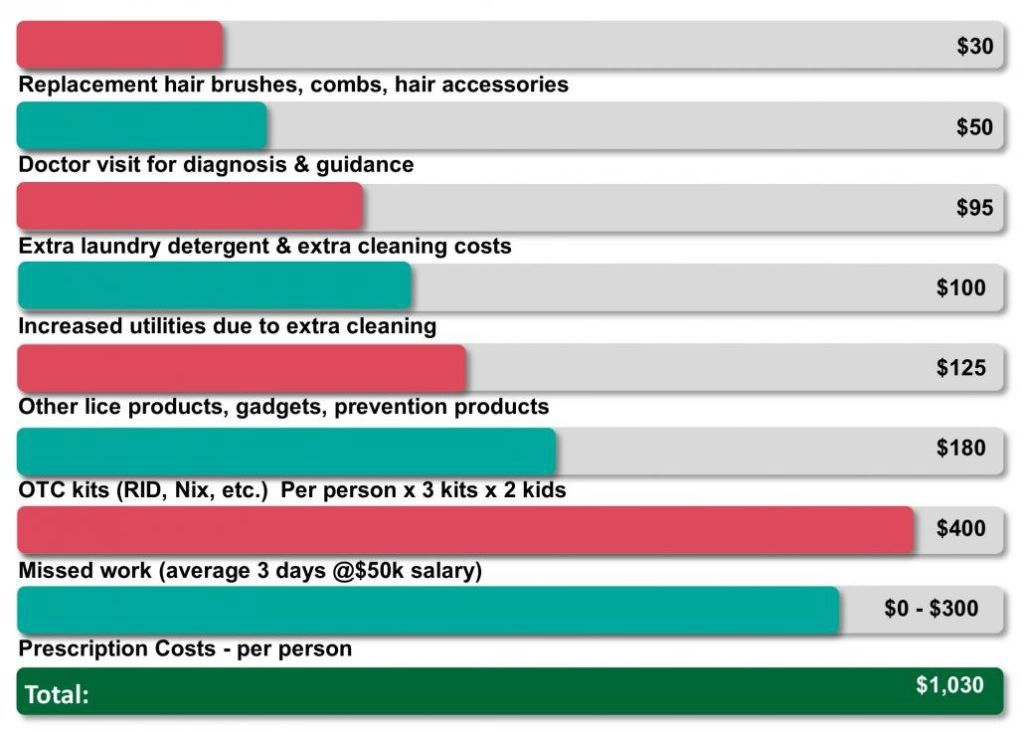Head Lice Facts
CDC
According to the CDC, there are reported 6 to 12 million children ages 3 to 11 in the US infested with head lice each year. Very often, parents and children over the age of 11 contract head lice, so the real number of cases each year is unknown.
Super Lice
SUPER LICE are real, and they are making it ALMOST IMPOSSIBLE for you to get rid of lice yourself. Our technology and process kill 100% of lice, even super lice, every time. Super lice evolved because of repeated exposure to the chemicals in the most popular over-the-counter (OTC) products over nearly 50 years! Repeated exposure builds resistance, not only to that particular treatment, but to virtually all similar products. Therefore, OTC products no longer work very well, which means that most people are simply wasting their money on OTC treatments. On top of that, you may just be prolonging the misery because it can take a week or more to determine that an OTC treatment has failed.

Cost
Doing it yourself can quickly become more expensive than a professional treatment.
Even if you have a form of lice that is not resistant, OTC products will require multiple treatments over several weeks (read the packaging closely) because they cannot kill eggs/nits. And those treatment costs add up quickly, about as quickly as your frustration with their ineffectiveness!
More Head lice facts...
Head lice have been around for millions of years, and dried-up lice and their eggs have been found on the hair and scalps of Egyptian mummies! Head lice do not come out of the air or from the ground. They are human parasites that feed on blood and travel from one head to another. Head lice are uniquely adapted to be on human head hair.
Head lice can be spread whenever there is direct head-to-head contact with an infested individual. Lice may also be transmitted by items such as hats, hair ties, scarves, pillows, etc. However, this type of transfer is probably quite rare.
Lice cannot typically survive off of a human host longer than 24 hours, and they are uniquely adapted for living in human head hair. They generally do not like to leave the protected environment created within their head hair.
Head lice are most commonly found on the scalp, behind the ears, and near the neckline at the base of the head. Symptoms include a tickling sensation or feeling something moving through the hair. An allergic reaction to the bites causes itching. Viable eggs are usually located within 1/4 inch (6 mm) of the scalp.
The adult louse is no bigger than a sesame seed and is grayish-white or tan. The color of lice varies based on your hair color. Nymphs (baby lice) are smaller and can be black, clear, or even blood-red. Lice eggs, often called nits, look like tiny yellow, tan, or brown dots before they hatch. After hatching, the remaining shell looks white or clear. Nits are literally glued to the hair shaft and are very difficult to remove.
The cold air process, using Zyma Air Therapy, is a safe and comfortable treatment that is highly effective at not only killing the live lice but also their eggs. Increasing numbers of consumers are finding that the most popular treatments for head lice, including chemical shampoos and home remedies, are largely ineffective. Head lice are rapidly evolving chemical resistance to many of the traditional pesticide-based control methods (which have never been able to kill eggs (nits) effectively and usually require repeated treatments). Louse combs can be effective for removing lice and eggs, but the comb-out process can be very tedious, and many busy parents do not have the time or patience for effective combing. In desperation, some parents resort to home remedies such as bug spray, mayonnaise, or kerosene, but there is little hard evidence that these remedies are effective, and some home remedies can actually be harmful. As a result, parents and school authorities are searching for a safe, fast, and effective treatment that will solve the problem and help keep children in or quickly return them to school.
Eggs are laid by adult female lice and usually take about a week to hatch into nymphs. Nymphs: Nymphs are immature lice that mature into adults about a week after hatching from the egg. Adults: Adult lice can live about 30 days on a person’s head. If they come off the host, they usually die within 24 hours. Female adult lice lay 4 to 8 eggs per day and can lay 100 or more eggs during their lifetime. The eggs are glued to hair shafts and hatch in 4–10 days. It takes another 9–12 days for the female louse to mature. She mates 24 hours later and starts laying eggs.
There is not a difference, although a nit is usually referred to as the empty shell and the egg as a viable egg. Sometimes people refer to one or the other in relation to its viability.
Although a microscope would be able to show you whether an egg is empty or not, there is no way to tell whether a non-empty shell is viable or not.
Avoid head-to-head contact during play, sleepovers, or other activities at home, school, and elsewhere. Do not share combs, brushes, or towels used by an infested person. Do not share clothing such as hats, scarves, coats, hair ribbons, or barrettes. Machine wash and dry clothing, bed linens, and other items that an infested person used or wore during the previous 2 days using a hot water laundry cycle and high heat drying cycle. Do not use fumigant sprays or fog; they are not necessary to control head lice and can be toxic if inhaled or absorbed through the skin.
It is very common for close family or friends of infested individuals to also have lice. It is suggested that you check everyone in the household. You do not want to treat anyone who does not have lice; however, many clients who have a family member with lice will choose to have a dimethicone oil treatment. This treatment, which is completely non-toxic, is a quick and easy way to kill any small bug that may be in the hair but is very hard to find.
Vacuum the carpet and furniture; wash bedding and clothing in very hot water; place pillows in a dryer at the highest heat setting for 20 to 30 minutes; boil hair ties/hairbrushes for 10 to 20 minutes or freeze them in a plastic bag overnight. Head lice cannot survive off of a human head for more than 24 hours. It is recommended that you do not use pesticide sprays in your home; they will unnecessarily expose your household to harmful chemicals.
You can place them on the top rack of the dishwasher or soak items in HOT (not boiling) water for 20 minutes. You can also put them in a plastic bag in the freezer for 24 hours.



